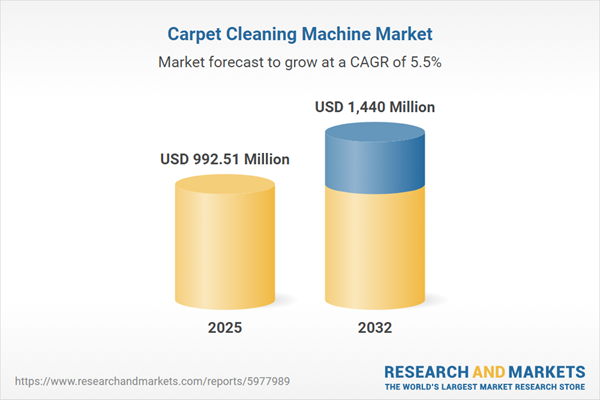Speak directly to the analyst to clarify any post sales queries you may have.
The carpet cleaning machine market is evolving rapidly as businesses and consumers seek advanced solutions that streamline operations, enhance sustainability, and adapt to changing regulatory landscapes. Market participants must keep pace with emerging technologies and shifting end-user expectations to sustain competitive advantage.
Market Snapshot: Carpet Cleaning Machine Market Size & Growth
The carpet cleaning machine market grew from USD 942.01 million in 2024 to USD 992.51 million in 2025. It is anticipated to continue expanding at a CAGR of 5.45%, reaching USD 1.44 billion by 2032. This market trajectory reflects strong demand across both commercial and residential sectors, fueled by increasing hygiene standards, ongoing product innovation, and the adoption of more sustainable cleaning practices.
Scope & Segmentation
This research delivers granular analysis of market segments and regional developments, offering insights for stakeholders targeting high-impact opportunities:
- Technology: Dry foam, encapsulation, hot water extraction (including both high-temperature and low-temperature methods)
- Product Types: Handheld, robotic (covering camera-based, infrared, and lidar systems), upright machines
- Distribution Channels: Offline retail (encompassing mass merchants and specialty stores), online retail
- Power Sources: Battery-powered, electric corded, fuel-powered
- End Use: Commercial, residential
- Operation Modes: Automatic (covering one-touch and programmable systems), manual
- Regional Coverage: Americas (including North America and Latin America), Europe, Middle East & Africa, Asia-Pacific (covering major economies and growth markets)
- Key Players Analyzed: Alfred Kärcher SE & Co. KG, Nilfisk A/S, Tennant Company, Inc., Hako GmbH, Techtronic Industries Co., Ltd, Bissell Inc., Rug Doctor LLC, Oreck Corporation, SEBO AG, Prochem Europe Ltd
Key Takeaways
- Carpet cleaning machines are at the center of integrated cleaning strategies, balancing efficiency with durability and the user experience across industries such as hospitality and healthcare.
- Technological advancements, such as digital control panels and AI-driven navigation, are rapidly redefining operational workflows and enabling smarter maintenance.
- Sustainability is a critical driver, propelling the adoption of devices with lower water usage, improved filtration, and compatibility with eco-friendly cleaning agents.
- Regional differences shape equipment standards: the Americas prioritize hot water extraction for regulatory compliance, Europe and Africa favor dry cleaning methods due to water limitations, while Asia-Pacific drives compact and programmable solution demand amid rapid urban growth.
- Strategic collaborations, such as partnerships between technology firms and manufacturers, are facilitating innovations in control systems and expanding market reach through unified service agreements.
Tariff Impact: Navigating the 2025 US Tariffs
The introduction of new United States tariffs in 2025 has changed the global supply and sourcing landscape. Manufacturers are facing higher input costs for essential components and are reassessing procurement strategies, including seeking alternative suppliers and greater vertical integration. Distribution channels are adapting inventory management and lead times to offset tariff pressures. Investments in domestic assembly are increasing, strengthening local supply resilience and reducing vulnerability to further trade actions.
Methodology & Data Sources
This report is anchored on a combination of secondary industry sources, in-depth interviews with global stakeholders, and quantitative surveys with buyers and distribution partners. All data has been triangulated and peer-reviewed by subject matter experts to ensure accuracy and actionable insights.
Why This Report Matters
- Offers senior leaders clear guidance for adapting to regulatory changes and leveraging technology trends in the carpet cleaning machine market.
- Equips decision-makers with segmentation analysis to identify profitable niches and optimize go-to-market strategies regionally and by operational mode.
- Delivers actionable recommendations for strengthening supply chain resilience, driving sustainability, and forging strategic partnerships.
Conclusion
The carpet cleaning machine market presents distinct opportunities for innovation, operational efficiency, and business growth. Informed, strategic decision-making enables organizations to capitalize on emerging technologies and evolving market forces more effectively.
Additional Product Information:
- Purchase of this report includes 1 year online access with quarterly updates.
- This report can be updated on request. Please contact our Customer Experience team using the Ask a Question widget on our website.
Table of Contents
3. Executive Summary
4. Market Overview
7. Cumulative Impact of Artificial Intelligence 2025
Companies Mentioned
The companies profiled in this Carpet Cleaning Machine market report include:- Alfred Kärcher SE & Co. KG
- Nilfisk A/S
- Tennant Company, Inc.
- Hako GmbH
- Techtronic Industries Co., Ltd
- Bissell Inc.
- Rug Doctor LLC
- Oreck Corporation
- SEBO AG
- Prochem Europe Ltd
Table Information
| Report Attribute | Details |
|---|---|
| No. of Pages | 189 |
| Published | November 2025 |
| Forecast Period | 2025 - 2032 |
| Estimated Market Value ( USD | $ 992.51 Million |
| Forecasted Market Value ( USD | $ 1440 Million |
| Compound Annual Growth Rate | 5.4% |
| Regions Covered | Global |
| No. of Companies Mentioned | 11 |









